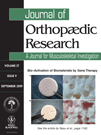Meniscus structure in human, sheep, and rabbit for animal models of meniscus repair
Abstract
Meniscus injury is a frequently encountered clinical orthopedic issue and is epidemiologically correlated to osteoarthritis. The development of new treatments for meniscus injury is intimately related to the appropriateness of animal models for their investigation. The purpose of this study was to structurally compare human menisci to sheep and rabbit menisci to generate pertinent animal models for meniscus repair. Menisci were analyzed histologically, immunohistochemically, and by environmental scanning electron microscopy (ESEM). In all species, collagen I appeared throughout most menisci, but was absent from the inner portion of the tip in some samples. Collagen II was present throughout the inner main meniscal body, while collagen VI was found in pericellular and perivascular regions. The glycosaminoglycan-rich inner portion of menisci was greater in area for rabbit and sheep compared to human. Cells were rounded in central regions and more fusiform at the surface, with rabbit being more cellular than sheep and human. Vascular penetration in rabbit was confined to the very outermost region (1% of meniscus length), while vessels penetrated deeper into sheep and human menisci (11–15%). ESEM revealed a lamellar collagenous structure at the articulating surfaces of sheep and human menisci that was absent in rabbit. Taken together, these data suggest that the main structural features that will influence meniscus repair—cellularity, vascularity, collagen structure—are similar in sheep and human but significantly different in rabbit, motivating the development of ovine meniscus repair models. © 2009 Orthopaedic Research Society. Published by Wiley Periodicals, Inc. J Orthop Res




